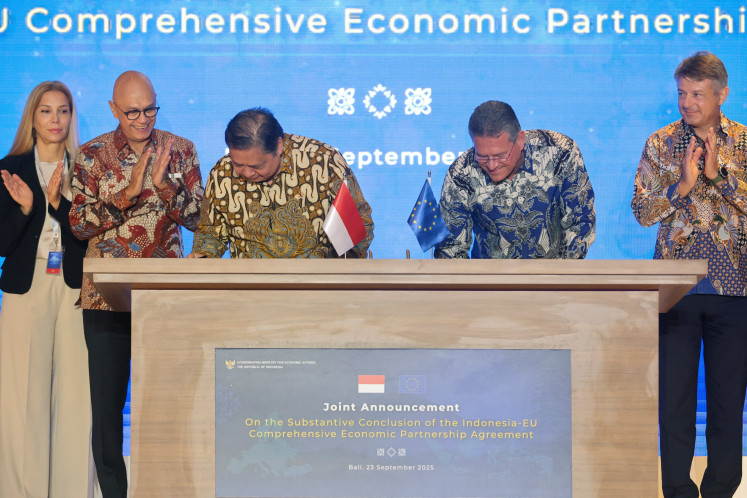Popular Reads
Top Results
Can't find what you're looking for?
View all search resultsPopular Reads
Top Results
Can't find what you're looking for?
View all search resultsJavanese antiquities in Paris
The face of Buddha: The head, made of andesite and measuring 32 centimeters high, bears all the hallmarks of Central Javanese sculptural style, as evident by its round head
Change text size
Gift Premium Articles
to Anyone
T
span class="caption" style="width: 404px;">The face of Buddha: The head, made of andesite and measuring 32 centimeters high, bears all the hallmarks of Central Javanese sculptural style, as evident by its round head.
As Indonesia is drained of its precious cultural heritage; some antique collectors, dealers and museums pride themselves on their 'priceless' collections of Indonesian artifacts ' some obtained legally, some not.
However, in Paris, one museum is properly preserving artifacts from Indonesia that date from the 8th to 12th centuries.
Visitors to the Indonesian section of the Guimet Museum, the French national museum dedicated to Asian art, are greeted by a serene Buddha's head sitting on a 1.5-meter pedestal.
Believe it or not, the piece, although having moved thousands of miles from the misty hills of Central Java where it was made, still radiates an aura of mysticism.
The head, made of andesite and measuring 32 centimeters high,
bears all the hallmarks of Central Javanese sculptural style, as evident by its round head.
Its broad, majestic and serene face has with lowered eyes that suggest contemplation. A slightly hooked nose and a thin-and-well defined upper lip gives the statue with a friendly smile.
Gumiet Museum: The French national museum for Asian art holds an impressive Indonesian collection.
A nearby placard explains that the statue, which originated from Borobudur Temple, was acquired in 1920 and donated to the museum by a private collector in 1958.
The donation to the museum was made philanthropically, to give the international public better access to the culture and art of the indigenous people in Asia and the Pacific.
Protection of art and cultural treasures was deemed necessary following intensive 'exploration' work by archeologists, anthropologists and ethnographers in the 19th century. As a result, major museums in Europe previously adopted a rule prohibiting the procurement of artifacts obtained through clandestine means.
Antiquities originating from Indonesia have been donated to the Guimet Museum as far back as the early 20th century. A list of donors placed at its main entrance hall acknowledges those who have contributed their cherished pieces to improve understanding of Asian cultures.
The Guimet's collection of classic Indonesian sculptures includes a rare Siva statue that dates to between the 10th and 12th centuries. Though partly damaged, the statue still offers much of the sculptor's vision for admiration. Sitting cross-legged on a lotus cushion to signify his divine status, this Siva is portrayed with four arms.
Cultural pundit Endang Sri Hardiati, an archaeological researcher and the director of the National Museum of Indonesia from 1999 to 2004, has studied the piece. 'The statue portrays Siva in his position as the highest priest. In this status, Siva is entitled to wear royal garb and royal jewelry, as well as an ornate crown,' Endang said at a recent talk in Jakarta.
The partially damaged Siva statue is also shown with his particular attributes, including a flyswatter that symbolizes his power to cast out negative influences. Another attribute, a rosary he wears around the neck, symbolizes wisdom gleaned through deep prayer, while the water pitcher in his upper right hand contains holy water and the snake's head resting on his shoulder is part of his caste-chain.
Agastya: This statue of Agastya, who is credited with propagating Hinduism in Java, originated from Nagasari Temple from the Prambanan complex in Yogyakarta.
Although the statue originates from East Java, it retains the round reliefs traditional found in Central Javanese sculpture. The Siva, which stands 90 centimeters high, was carved from volcanic stone and acquired through a donation.
Another impressive piece in the Guimet's collection is a bronze statue of Avalokitesvara, the god of compassion and mercy. Here the Buddhist deity is portrayed as a young man with five arms branching from each elbow. Standing in perfect balance, it reflects the superb craftsmanship of Central Javanese bronze smiths working in the 8th and 9th centuries.
Several Avalokitesvara statues have been found in Java and Sumatra, including four in the collection of the National Museum. However, none of these has 10 arms, making the Guimet's Avalokitesvara.
Measuring 34 by 20 by 8 centimeters, the figurine has a lower left hand holding a lotus flower, signifying his status as a deity, and a scroll in another hand, indicating that he ranks among the literati.
As is often the case with figures of deities, Avalokitesvara is pictured with a halo of flames.
'Despite being venerated as a Budhist deity, he wears a Brahmanic chain, as well as gold jewelry. The tiger skin around the hips reveals a Siva influence. This blend of Budhist and Hindu influences is very common in Central Java,' Endang said.
She continued: 'The statue, with its face immersed in deep introspection, is a jewel of craftsmanship. It displays all the characteristics of a fine art work, with its soft and sensitive modeling, as is also reflected on the statuette's friendly and smiling face.'
Siva: Though partly damaged, the statue still offers much of the sculptor's vision.
Another important piece in the Guimet's collection is a statue of Agastya originating from Nagasari Temple from the Prambanan complex in Yogyakarta.
Agastya, credited for propagating Hinduism in Java, is identifiable by his beard and moustache, sturdy body and round belly. The statue has cast him with the attributes of Siva, including a flyswatter, a rosary, a Sivaite caste chain as well as an ornate crown.
The Siva influences found in many statues indicates that devotion to the deity was at one time widespread in Java.
The Guimet also features a number of smaller pieces from Indonesia, including a statue of Kuwera, the god of wealth. It's small size ' only 15 centimeters tall ' and unappealing appearance leads museum patrons to overlook it.
Kuwera is believed to have shown honest dedication to his profession as a treasurer. For this, devotees honor him as a deity and have seated him on a lotus cushion amid pots of money. Those with financial problems pray to Kuwera for help. Commensurate with his status, he is portrayed wearing jewelry and an ornate crown.
It is heartening to see the keen interest of visitors from all over the world in the more than 50 statues in the Guimet's Indonesian section.
Unlike the compartementalized and cluttered divisions at the National Museum in Jakarta, which allow would-be culprits to hide behind doors and staircases while waiting for the right moment to rob antiquities, the pleasant arrangement of antiquities in the Indonesian display hall at the Guimet allows visitors to move freely while discouraging mischief.
When in Paris, a visit to the Guimet can be enlightening.
For more information, visit guimet.fr.
Images courtesy of Sailko and Olybrius













